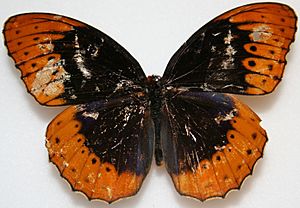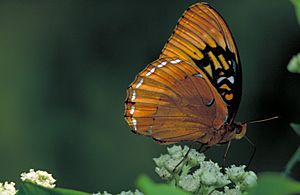Diana fritillary facts for kids
Quick facts for kids Diana fritillary |
|
|---|---|
 |
|
| Male | |
| Conservation status | |
| Scientific classification |
The Diana fritillary (Speyeria diana) is a beautiful butterfly found in forests across parts of southern and eastern North America. You can spot them in places like the Arkansas River valley, parts of South Carolina, along the Appalachian Mountains, and on the southern Cumberland Plateau.
These butterflies are special because the males and females look very different. This is called sexual dimorphism. Male Diana fritillaries have bright orange edges on their wings and a burnt orange color underneath. Female Diana fritillaries are larger and have dark blue wings with dark, almost dusty-looking undersides.
Contents
Life of a Diana Fritillary
Diana fritillary butterflies have an interesting life cycle.
What They Eat
The young butterflies, called larvae or caterpillars, love to eat the leaves of violet plants.
Adult Diana fritillaries drink nectar from flowers. They also sometimes feed on dung (animal waste), which gives them important nutrients.
Egg Laying Habits
Unlike many other butterflies, Diana fritillaries do not lay their eggs directly on the plants their larvae will eat. Instead, they scatter their eggs around the base of violet plants.
When the eggs hatch, the tiny larvae burrow into the ground. They stay underground all winter long. In the spring, they emerge and start munching on violet leaves.
Arkansas State Butterfly
On February 28, 2007, the state of Arkansas chose the Diana fritillary as its official state butterfly. This decision was made by the Arkansas General Assembly, a group of lawmakers.
Representative John Paul Wells from Logan County introduced the idea. He believed the butterfly was beautiful and important for education and tourism. Arkansas is the only state to have the Diana fritillary as its state butterfly. It joins the honeybee, which is Arkansas's state insect. Arkansas was the twenty-sixth state to choose a butterfly as a state symbol.
Challenges for Diana Fritillaries
These amazing butterflies face some challenges that could affect their future.
Habitat Loss
One big threat is the loss of their natural homes, called habitats. As forests are cleared for farms or buildings, the Diana fritillaries lose the places where they live and find food.
Climate Change Effects
Climate change is also a concern. It is changing the natural environments where Diana fritillaries live. Scientists expect that populations in the Appalachian Mountains and other western areas might decrease.
Experts predict that the overall number of Diana fritillary butterflies could go down by the year 2050 if these threats continue.



